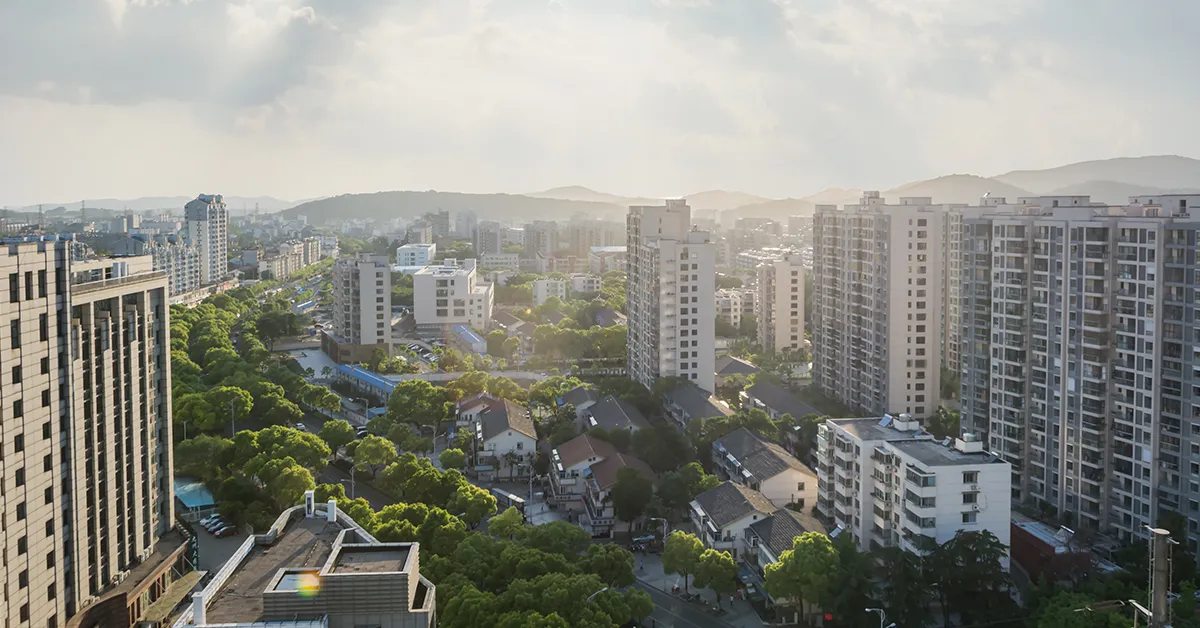The implementation of Goods and Services Tax (GST) reforms has fundamentally altered India’s real estate sector, with particularly significant implications for luxury residential projects in gurgaon. Gurgaon is one of the largest luxury markets in the National Capital Region, and the changes in the buyer behavior, pricing transparency, and investment trends after these measures were taken became quite significant in Gurgaon.
Table of Contents
Understanding GST’s Impact on Luxury Real Estate
The introduction of GST on under-construction luxury residential properties in gurgaon has created a more standardized and transparent pricing framework. Residential properties are now taxed at 5 per cent GST (non-affordable housing) on properties valued above 45 lakh and 12 per cent GST is imposed on commercial properties (CBIC). This restructuring was effected with recommendations of the GST Council in March 2019 (as reported by ClearTax and reported by official CBIC notifications), and eliminated the mishmash of various taxes such as VAT, service tax and stamp duty variations and made what used to be a jumbled pricing model clear. For luxury residential apartments in gurgaon, this standardization has eliminated the confusion surrounding hidden costs and additional charges that buyers previously encountered.
The introduction of the GST has especially helped those high-end property buyers by levelling tax rates in the various stages of projects. According to a Knight Frank India report, previously, luxury residential properties in gurgaon were subject to varying tax structures depending on project completion stages, creating uncertainty for investors. The new structure means that whether one is buying at the foundation phase or at the completion phase, buyers have to pay similar taxes.
Market Dynamics and Buyer Behavior Shifts
The luxury real estate industry in Gurgaon has also experienced a major change in the decision making pattern by the buyers that took place after the implementation of GST. According to ANAROCK Property Consultants, the transparent pricing structure has encouraged more institutional investors and high-net-worth individuals to consider luxury residential projects in gurgaon as viable investment options. This has been experienced mostly in the areas relating to the Dwarka Expressway and the NH-48 areas whereby high-end developments have received more investor confidence.
The reform has also standardized the documentation process, making it easier for buyers to compare different luxury residential apartments in gurgaon on a like-for-like basis. According to JLL India study, this transparency has aggravated competition among the developers forcing them to come up with superior value propositions instead of using complicated pricing systems to distinguish their offerings.
Price Transparency and Market Standardization
The introduction of GST reforms has contributed to the removal of a series of different tax levels which in the past added value to the end price of luxury properties. Based on the industry analysis by BankBazaar and Groww, under the previous regime, customers mostly found out that there were extra fees to be paid in the course of the transaction process, which generated conflicts and delays. The existing 5 percent GST on residential property exceeding 45 lakh (12 percent on commercial units as per the guidelines of the CBIC) gives full cost transparency at the first booking level.
This openness has especially helped the luxury market, which deals mostly with high values of transactions and any concealments would create a great financial burden. Luxury residential properties in gurgaon now offer buyers clear understanding of total investment requirements, enabling better financial planning and decision-making.
The standardization has also gained momentum on the resale market of the luxury homes as buyers are now able to determine properly the value of the property without fear of different tax implications in different projects or developers. According to a report by PropTiger, this has brought about a surge in liquidity in the luxury real estate segment of Gurgaon due to this kind of transparency.
Established Developers Leading the Transformation
The developed players in this reformed landscape have become the leaders of the market because they have picked up easily with the GST compliance rules without compromising on their luxury and quality. According to a CBRE report, established real estate developer in gurgaon companies have invested heavily in upgrading their financial systems, ensuring seamless GST implementation while protecting buyer interests.
This adaptative strategy is effective by Ganga Realty who had a lot of experience in luxury development and used it to cope with the post-GST environment efficiently. Having established strong reputation concerning the provision of high quality residential projects, the company has found itself better placed in the reformed structure of the market in which transparency and compliance have become significant points of difference.
Ganga Realty: Excellence in the GST Era
As a prominent real estate developer in gurgaon, Ganga Realty has demonstrated exceptional capability in managing the transition to GST compliance while continuing to deliver world-class luxury residential apartments in gurgaon. The transparency adopted by the company is exactly what the reformed tax structure focuses on in terms of clear and standard pricing.
The company has a flagship project called Ganga Realty Nandaka in Sector 84, which is one of the latest examples of how the established developers are performing in the post-GST environment successfully. This is a high-end project that has 3 BHK and 4 BHK spacious apartments covering 8.35 acres and each room contains a servant quarters and utility spaces. The strategic positioning of the project at NH-48 and Dwarka expressway offers good connectivity and at the same time keeps the exclusiveness that a luxury customer is in need of.
The ganga realty nandaka project showcases the developer’s ability to deliver comprehensive luxury living experiences while maintaining complete GST compliance and pricing transparency. This strategy has appealed to discriminating consumers who appreciate the luxury features, as well as regulatory compliance.
The fact that Ganga Realty became one of the founding members of the Indian Green Building Council (IGBC) also indicates that they are highly dedicated to the concept of sustainable luxury development, which has gained even greater significance among those buyers of luxury property who are environmentally conscious. They are centered on the philosophy of virtue flows unbridled and this has provided them with developments with a sense of both luxury and environmental concern.
The Ganga Realty Nandaka project and the company’s comprehensive approach to luxury residential projects in Gurgaon spans multiple successful developments, each characterized by contemporary architecture, premium finishes, and comprehensive amenities. The consistency has positioned Ganga Realty as a brand name among customers who have confidence in the company as a real estate developer in the reformed market set up of Gurgaon.
Conclusion: GST Reforms and Developer Selection
The GST reforms have provided a clearer and more standardized luxury real estate property market in Gurgaon, which favors the buyers and the well-established developers who are interested in compliance and transparency in the real estate properties. For investors considering luxury residential properties in gurgaon, partnering with experienced developers like Ganga Realty ensures not only regulatory compliance but also access to premium amenities, strategic locations, and proven construction quality. With the market still dynamic under the GST regime, it is essential to have the developers who have a proven track record in luxury development and regulatory adherence to have a successful time in the investment of the property. The ganga realty nandaka project and the company’s comprehensive approach to luxury development exemplify how the right developer can maximize the benefits of GST reforms while delivering exceptional living experiences.
GST reforms have made the luxury real estate market in Gurgaon more transparent and standardized which has been beneficial to the buyers and established developers who value compliance and transparency. In the case of investors looking at the luxury residential property in gurgaon, by collaborating with an established developer such as Ganga Realty, they are assured of compliance with the rules and regulations as well as having access to high quality amenities, strategic location and effective construction work. With the market constantly changing under the GST regime, it is important to select developers who will show experience in the development of luxury and adherence to the regulations to effectively invest in property. The ganga realty nandaka project and overall attitude of the company to luxury development is a good example of how the appropriate developer may capitalize the advantages of GST reforms and provide superior living experience at the same time.
FAQs
2: How has GST improved transparency in luxury real estate transactions?
GST reforms have eliminated the previous complex system of multiple taxes including VAT, service tax, and varying stamp duty charges. According to industry analysis by BankBazaar and Groww, the standardized 5% GST on residential properties above ₹45 lakh provides complete cost transparency at the booking stage itself, eliminating hidden costs and additional charges that buyers previously encountered during the transaction process.
3: Does GST apply differently based on project completion stages?
No. According to a Knight Frank India report, one of the major benefits of GST implementation is the uniform tax rate across all project stages. Whether you purchase a property at the foundation stage or near completion, the GST rate remains consistent, eliminating the uncertainty that existed under the previous tax regime where rates varied depending on project completion stages.
4: How has GST affected buyer behavior in Gurgaon’s luxury real estate market?
According to ANAROCK Property Consultants, the transparent pricing structure created by GST has encouraged more institutional investors and high-net-worth individuals to consider luxury residential projects in Gurgaon as viable investment options. This shift has been particularly noticeable in areas along Dwarka Expressway and NH-48, where high-end developments have gained increased investor confidence.
5: What is Ganga Realty Nandaka, and how does it comply with GST regulations?
Ganga Realty Nandaka is a flagship luxury residential project in Sector 84, spread across 8.35 acres, featuring spacious 3 BHK and 4 BHK apartments with servant quarters and utility spaces. The project maintains complete GST compliance with transparent pricing structures. Strategically positioned near NH-48 and Dwarka Expressway, it exemplifies how established developers successfully operate in the post-GST environment while delivering world-class luxury living experiences.
6: How has GST standardization affected competition among developers?
According to a JLL India study, GST’s transparent pricing framework has intensified competition among developers by making it easier for buyers to compare different luxury residential apartments in Gurgaon on a like-for-like basis. This transparency has forced developers to differentiate themselves through superior value propositions, quality construction, and comprehensive amenities rather than complex pricing strategies.








